William Pulteney, 1st Earl of Bath
Last updatedThe Earl of Bath | |
|---|---|
 Earl of Bath, 1761, by Sir Joshua Reynolds | |
| Prime Minister of Great Britain | |
Disputed | |
| In office 10 February 1746 –12 February 1746 | |
| Monarch | George II |
| Preceded by | Henry Pelham |
| Succeeded by | Henry Pelham |
| Secretary at War | |
| In office 1714–1717 | |
| Monarch | George I |
| Preceded by | Francis Gwyn |
| Succeeded by | James Craggs the Younger |
| Personal details | |
| Born | William Pulteney 22 March 1684 Leicestershire,England |
| Died | 7 July 1764 (aged 80) |
| Resting place | Westminster Abbey |
| Political party | Whig |
| Spouse | Anna Maria Gumley (m. 1714;died 1758) |
| Children | William Pulteney, Viscount Pulteney |
| Alma mater | Christ Church, Oxford |
| Occupation | Politician |
| Cabinet | Short-lived ministry |

William Pulteney, 1st Earl of Bath, PC (22 March 1684 –7 July 1764) was an English Whig politician and peer who sat in the British House of Commons from 1707 to 1742 when he was raised to the peerage as the Earl of Bath by George II of Great Britain. He is sometimes represented as having served as First Lord of the Treasury and Prime Minister of Great Britain as part of the short-lived ministry in 1746, although most modern sources do not consider him to have held the office.
Contents
Background and early career
The son of William Pulteney by his first wife, Mary Floyd, he was born in March 1684 into an old Leicestershire family. He was educated at Westminster School and at Christ Church, Oxford, matriculating on 31 October 1700. He acquired extensive classical knowledge, and on leaving Oxford made the usual tour on the continent. In 1705, he was brought into parliament by Henry Guy (former secretary of the Treasury) for the Yorkshire borough of Hedon. This seat was held by him without a break until 1734. [1] [2]
Throughout the reign of Queen Anne William Pulteney played a prominent part in the struggles of the Whigs, and was involved in the prosecution of Henry Sacheverell. When the victorious Tories sent his friend Robert Walpole to the Tower of London in 1712, Pulteney championed his cause in the House of Commons and with the leading Whigs visited him in prison. [3]
Ministerial offices
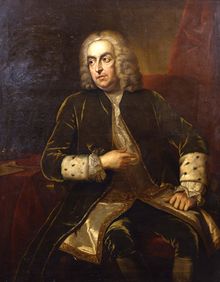
Pulteney was secretary of war from 1714 to 1717 in the first ministry of George I, and was on the committee of secrecy on the Treaty of Utrecht, formed in April 1715. Two years later, on 6 July 1716, he became one of the privy council. When Townshend was dismissed, in April 1717, from his post of Lord Lieutenant of Ireland, and Walpole resigned, they were followed in their retirement by Pulteney.
The crash of the South Sea Company restored Walpole to the highest position, but all he offered to Pulteney was a peerage. Pulteney rejected the offer, but in May 1723 Pulteney agreed to accept the lucrative but insignificant post of Cofferer of the Household. However, when he found himself neglected, he opposed the proposition of Walpole to discharge the debts of the civil list, and in April 1725 was dismissed from his sinecure. [3]
He was one of the original backers of the Royal Academy of Music, establishing a London opera company which commissioned numerous works from Handel, Bononcini and others. [4]
Patriot Whigs
From the day of his dismissal to that of his ultimate triumph, Pulteney remained in opposition, forming the Patriot Whigs, a group of fellow Whigs who felt that Walpole was corrupt and tyrannical. Walpole's attempt's 1730 at conciliation with the offer of Townshend's place and of a peerage was spurned. Pulteney's resentment was not confined to his speeches in parliament.
With Bolingbroke he started, in December 1726, a periodical called The Craftsman , and in its pages the minister was incessantly denounced for many years. Lord Hervey published an attack on the Craftsman, and Pulteney, either openly or behind the person of Amhurst, its editor, replied to the attack. Whether the question at issue was the civil list, the excise, the income of the Prince of Wales, or the state of domestic affairs, Pulteney was ready with a pamphlet, and the minister or one of his friends came out with a reply.
For his "Proper reply to a late scurrilous libel" (Craftsman, 1731), an answer to "Sedition and defamation displayed," he was challenged to a duel by Lord Hervey; for another, "An answer to one part of an infamous libel entitled remarks on the Craftsman's indication of his two honourable patrons," he was in July 1731 struck off the roll of privy councillors and dismissed from the commission of the peace in several counties.
In print, Pulteney was inferior to Bolingbroke alone among the antagonists of Walpole, but in parliament, from which Bolingbroke was excluded, he excelled. When the sinking fund was appropriated in 1733 he led the denunciation; when the excise scheme in the same year was stirring popular feeling to its lowest depths the passion of the multitude broke out in his oratory. Walpole managed to avoid the fall of his ministry. Bolingbroke withdrew to France on the suggestion, it is said, of Pulteney, and the opposition was weakened by the dissensions of the leaders. [3]
From the general election of 1734 until his elevation to the peerage, Pulteney sat for Middlesex. [2] For some years after this election the minister's assailants made little progress in their attack, but in 1738 the troubles with Spain supplied them with the opportunity which they desired. Walpole long argued for peace, but he was feebly supported by his own cabinet, and the frenzy of the people for war knew no bounds. In an evil moment for his own reputation he consented to remain in office and to gratify popular passion with a war against Spain. His downfall was not long deferred. War was declared in 1739, a new parliament was summoned in the summer of 1741, and over the divisions on the election petitions the ministry of Walpole collapsed. [3]

The task of forming the new administration was after some delay entrusted to Pulteney, who offered the post of First Lord of the Treasury (Prime Minister) to the Earl of Wilmington, and contented himself with a seat in the cabinet and a peerage, still hoping to retain his supremacy in the ministry. This made him unpopular, and his influence dwindled to nothing. [3]
Horace Walpole asserts that when Pulteney wished to withdraw from the peerage it was forced upon him by the king, and another chronicler of the times records that when Walpole and Pulteney met in the House of Lords, the one as Earl of Orford, the other as Earl of Bath, the remark was made by Orford: "Here we are, my lord, the two most insignificant fellows in England." On 14 July 1742 Pulteney was created Baron Pulteney of Heydon, Viscount Pulteney of Wrington, Somerset, and Earl of Bath . On 20 February he had been restored to his rank in the privy council. At Wilmington's death in 1743 he made application to the king for the post of First Lord of the Treasury, only to find that it had been conferred on Henry Pelham. [3]
Prime minister
On 10 February 1746, Pelham's administration resigned en masse, and the king turned to Bath to form an alternative ministry. He accepted the seals of office and made nominations to the most senior posts, but it quickly became clear that he did not have enough support to form a viable government, and after "48 hours, three quarters, seven minutes, and eleven seconds" he abandoned the attempt, forcing the king to accept Pelham's terms for resuming office. As the office of Prime Minister did not then officially exist, it is a matter of controversy whether Bath should be considered to have been Prime Minister by virtue of his two-day ministry.
Bath's failed attempt to form a government brought him much ridicule. Horace Walpole recorded the joke that "Granville and Bath were met going about the streets, calling 'Odd Man', as the hackney chairmen do when they want a partner", [5] and a contemporary pamphlet satirically praised him for "the most wise and honest of all administrations, the minister having ... never transacted one rash thing; and, what is more marvellous, left as much money in the T[reasur]y as he found in it."
Death and legacy

An occasional pamphlet and an infrequent speech were afterwards the sole fruits of Bath's talents. His praises whilst in retirement have been sung by two bishops, Zachary Pearce and Thomas Newton. [3] In 1762, two years before his death, he served as treasurer of the Salop Infirmary in Shrewsbury. [6] He was buried on 17 July 1764, in his own vault in Islip chapel, Westminster Abbey. The monument is by the sculptor Joseph Wilton.
He married on 27 December 1714 Anna Maria, daughter and co-heiress of John Gumley of Isleworth, commissary general to the army who was often satirized by the wits of the day ( Notes and Queries , 3rd S. iI. 40 2-403, ~ 490). Anna Maria was the aunt of Rev. Dr. John Lockman, Canon of Windsor. She died on 14 September 1758, and their only son William Pulteney died unmarried at Madrid on 12 February 1763. Pulteney's vast fortune passed in 1767 to Frances, wife of William Johnstone and daughter and co-heiress of his cousin, Daniel Pulteney, a bitter antagonist of Walpole in parliament, and had taken the name of Pulteney. [3]
Of business he was never fond, and the loss in 1734 of his trusted friend John Merrill, who had supplied the qualities which he lacked, was lamented by him in a letter to Jonathan Swift. [3]
The town of Poultney, Vermont and the Poultney River were named for him. [7]
Cabinet of Lord Bath
| Portfolio | Minister | Took office | Left office |
|---|---|---|---|
| First Lord of the Treasury [8] | * | 10 February 1746 | 12 February 1746 |
| Lord Privy Seal [9] | 10 February 1746 | 12 February 1746 | |
| First Lord of the Admiralty [8] | 10 February 1746 | 12 February 1746 | |
| * | 10 February 1746 | 12 February 1746 |
Bibliography
- William Coxe, Memoirs of Sir Robert Walpole (1816), and of Henry Pelham (1829)
- John Morley, Walpole (1889)
- Walter Sichel, Bolingbroke (1901–1902)
- Archibald Ballantyne, Carteret (1887)
- Eng. Hist. Rev. iv. 749-753
- and the general political memoirs of the time. [3]
Related Research Articles

Robert Walpole, 1st Earl of Orford,, known between 1725 and 1742 as Sir Robert Walpole, was a British statesman and Whig politician who, as First Lord of the Treasury, Chancellor of the Exchequer, and Leader of the House of Commons, is generally regarded as the de facto first Prime Minister of Great Britain.

Henry Pelham was a British Whig statesman who served as Prime Minister of Great Britain from 1743 until his death in 1754. He was the younger brother of Thomas Pelham-Holles, 1st Duke of Newcastle, who served in Pelham's government and succeeded him as prime minister. Pelham is generally considered to have been Britain's third prime minister, after Robert Walpole and the Earl of Wilmington.
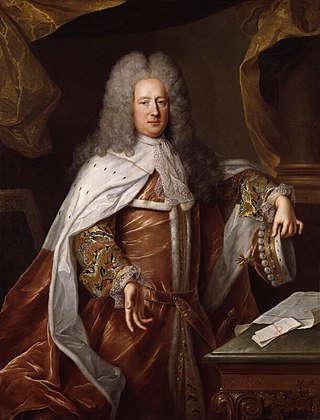
Henry St John, 1st Viscount Bolingbroke was an English politician, government official and political philosopher. He was a leader of the Tories, and supported the Church of England politically despite his antireligious views and opposition to theology. He supported the Jacobite rebellion of 1715 which sought to overthrow the new king George I. Escaping to France he became foreign minister for the Pretender. He was attainted for treason, but reversed course and was allowed to return to England in 1723. According to Ruth Mack, "Bolingbroke is best known for his party politics, including the ideological history he disseminated in The Craftsman (1726–1735) by adopting the formerly Whig theory of the Ancient Constitution and giving it new life as an anti-Walpole Tory principle."
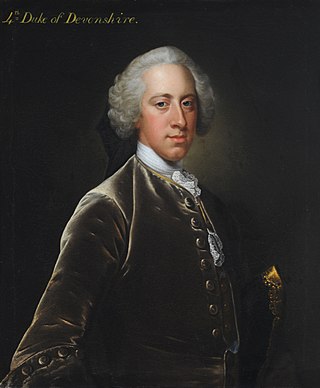
William Cavendish, 4th Duke of Devonshire,, styled Lord Cavendish before 1729, and Marquess of Hartington between 1729 and 1755, was a British Whig statesman and nobleman who was briefly nominal Prime Minister of Great Britain. He was the first son of William Cavendish, 3rd Duke of Devonshire and his wife, Catherine Hoskins. He is also a great-great-great-great-great-grandfather of King Charles III through the king's maternal great-grandmother.

Charles Townshend, 2nd Viscount Townshend, was an English Whig statesman. He served for a decade as Secretary of State for the Northern Department, 1714–1717, 1721–1730. He directed British foreign policy in close collaboration with his brother-in-law, prime minister Robert Walpole. He was often known as Turnip Townshend because of his strong interest in farming turnips and his role in the British Agricultural Revolution.

Spencer Compton, 1st Earl of Wilmington, was a British Whig statesman who served continuously in government from 1715 until his death in 1743. He sat in the English and British House of Commons between 1698 and 1728, and was then raised to the peerage and sat in the House of Lords. He served as the prime minister of Great Britain from 1742 until his death in 1743. He is considered to have been Britain's second prime minister, after Robert Walpole, but worked closely with the Secretary of State, Lord Carteret, in order to secure the support of the various factions making up the government.

Robert Harley, 1st Earl of Oxford and Earl Mortimer, KG PC FRS was an English statesman and peer of the late Stuart and early Georgian periods. He began his career as a Whig, before defecting to a new Tory ministry. He was raised to the peerage of Great Britain as an earl in 1711. Between 1711 and 1714 he served as Lord High Treasurer, effectively Queen Anne's chief minister. He has been called a prime minister, although it is generally accepted that the de facto first minister to be a prime minister was Robert Walpole in 1721.

Earl of Bath was a title that was created five times in British history, three times in the Peerage of England, once in the Peerage of Great Britain and once in the Peerage of the United Kingdom. It is now extinct.
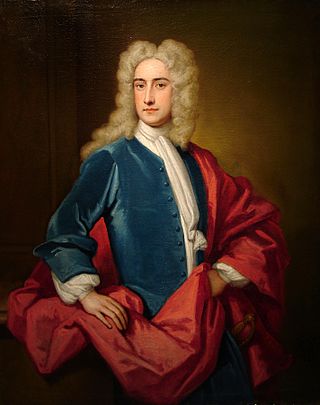
Samuel Sandys, 1st Baron Sandys, was a British Whig politician who represented Worcester in the House of Commons from 1718 until 1743, when he was created Baron Sandys. He held numerous posts in the government of the United Kingdom, namely Chancellor of the Exchequer, Leader of the House of Commons, Cofferer of the Household and First Lord of Trade. He was also a justice in eyre.

The Bath–Granville ministry, better known as the "short-lived" ministry, was a ministry of Patriot Whigs that existed briefly in February 1746.
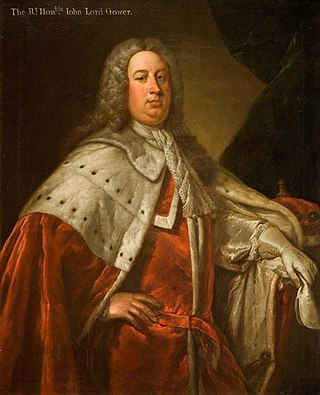
John Leveson-Gower, 1st Earl Gower, PC was an English Tory politician and peer who twice served as Lord Privy Seal from 1742 to 1743 and 1744 to 1754. Leveson-Gower also served in the Parliament of Great Britain, where he sat in the House of Lords as a leading member of the Tories, prior to switching his political affiliation and serving in various Whig-led government ministries until his death in 1754.
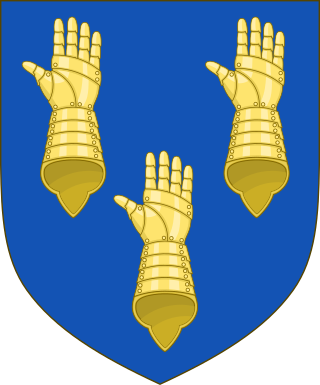
Henry Vane, 1st Earl of Darlington, PC, known as Lord Barnard between 1753 and 1754, was a British politician who sat in the House of Commons from 1726 to 1753 when he succeeded to a peerage as Baron Barnard.
The Patriot Whigs, later the Patriot Party, were a group within the Whig Party in Great Britain from 1725 to 1803. The group was formed in opposition to the government of Robert Walpole in the House of Commons in 1725, when William Pulteney and seventeen other Whigs joined with the Tory Party in attacks against the ministry. By the mid-1730s, there were over one hundred opposition Whigs in the Commons, many of whom embraced the Patriot label. For many years, they provided a more effective opposition to the Walpole administration than the Tories were.
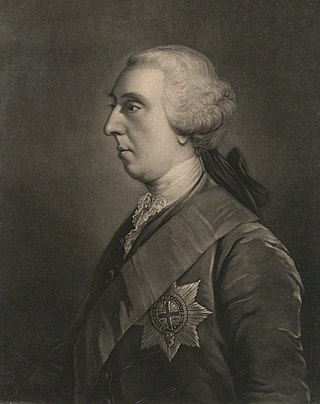
James Waldegrave, 2nd Earl Waldegrave, was an English politician and peer who is sometimes regarded as one of the shortest-serving prime ministers in British history. His brief tenure as First Lord of the Treasury is lent a more lasting significance by his memoirs, which are regarded as significant in the development of Whig history.
The Kingdom of Great Britain was governed by a caretaker government in April–June 1757—after the King's dismissal of William Pitt led to the collapse of the Pitt–Devonshire ministry amid the Seven Years' War. William Cavendish, 4th Duke of Devonshire, continued as the nominal head of government.

Charles (Medows) Pierrepont, 1st Earl Manvers was a British naval officer and politician who sat in the House of Commons from 1778 to 1796 when he was raised to the peerage as Viscount Newark.
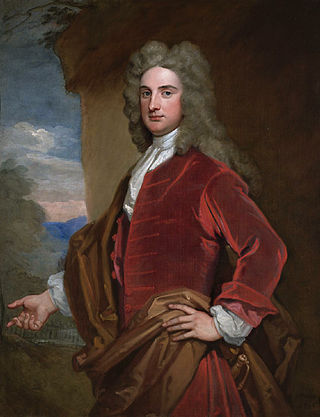
Sir John Rushout, 4th Baronet, of Northwick Park, Worcestershire was a British Whig politician who sat in the House of Commons for 55 years from 1713 to 1768. He was a supporter of Pulteney in opposition to Walpole, and was briefly part of an Administration. He was Father of the House from 1762.

Sir Edward Walpole KB PC (Ire) was a British politician, and a younger son of Sir Robert Walpole, Prime Minister from 1721 to 1742.
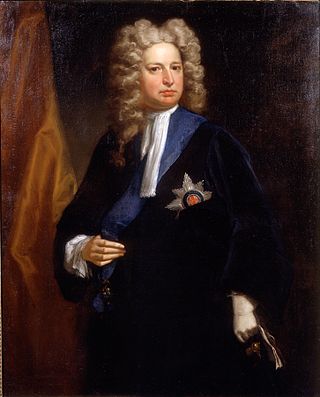
The Harleyministry was the British government that existed between 1710 and 1714 in the reign of Queen Anne. It was headed by Robert Harley and composed largely of Tories. Harley was a former Whig who had changed sides, bringing down the seemingly powerful Whig Junto and their moderate Tory ally Lord Godolphin. It came during the Rage of Party when divisions between the two factions were at their height, and a "paper war" broke out between their supporters. Amongst those writers supportive of Harley's government were Jonathon Swift, Daniel Defoe, Delarivier Manley, John Arbuthnot and Alexander Pope who clashed with members of the rival Kit-Kat Club.
John Wallop, 1st Earl of Portsmouth, of Hurstbourne Park, near Whitchurch and Farleigh Wallop, Hampshire, known as John Wallop, 1st Viscount Lymington from 1720 to 1743, was a British politician who sat in the House of Commons from 1715 to 1720, when he vacated his seat on being raised to the peerage as Viscount Lymington and Baron Wallop.
References
- ↑ Courtney 1911, pp. 510–511.
- 1 2 "PULTENEY, William (1684-1764)". History of Parliament Online. Retrieved 16 August 2018.
- 1 2 3 4 5 6 7 8 9 10 Courtney 1911, p. 511.
- ↑ Thomas McGeary. The Politics of Opera in Handel's Britain. Cambridge University Press, 2013. p.254
- ↑ Horace Walpole, Letter to Sir Horace Mann, 14 February 1746
- ↑ Keeling-Roberts, Margaret (1981). In Retrospect: A Short History of The Royal Salop Infirmary. North Shropshire Printing Company. p. ix. ISBN 0-9507849-0-7.List of Treasurers of the Royal Salop Infirmary; appears as 'William, Earl of Bath'.
- ↑ Room, Adrian (1989). Dictionary of World Place Names derived from British Names . Taylor & Francis. p. 144. ISBN 0-415-02811-6.
- 1 2 Haydn 1851, p. 93

- ↑ Haydn 1851, p. 93

- ↑ Cook & Stevenson 1988, p. 42; Haydn 1851, p. 93

Attribution:
- This article incorporates text from a publication now in the public domain : Courtney, William Prideaux (1911). "Bath, William Pulteney, Marquess of". Encyclopædia Britannica . Vol. 3 (11th ed.). pp. 510–511.
Bibliography
- Cook, Chris; Stevenson, John (1988), British Historical Facts: 1688–1760, Palgrave Macmillan UK, ISBN 978-1-349-02369-1
- Haydn, Joseph Timothy (1851), The Book of Dignities, London: Longman Brown
External links
- William Pulteney at the Eighteenth-Century Poetry Archive (ECPA)
- Works by or about William Pulteney, 1st Earl of Bath at Internet Archive
- Works by William Pulteney, 1st Earl of Bath at LibriVox (public domain audiobooks)
